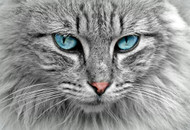Beyond Black and White: Demystifying Cat Vision and Color Perception
Posted by Wally Jack on 1st Mar 2024

For centuries, cats have captivated us with their grace, independence, and those mesmerizing eyes. Unlike most mammals, who possess a relatively similar range of vision to humans, cats offer a glimpse into a slightly different world, one where the vibrant tapestry of colors we experience is replaced with subtler nuances. However, to truly understand and appreciate our feline companions, we must venture beyond the myth of monochrome and delve into the fascinating realm of cat vision and color perception.
The Science Behind the Slit Pupils:
The key to understanding a cat's visual experience lies in the structure of their eyes. Unlike our trichromatic vision, which relies on three types of cone cells for perceiving a vast spectrum of colors, cats are dichromats. This means their retinas encompass only two types of cones, primarily geared towards detecting blue and green wavelengths. This limited color palette translates to a world where reds and oranges appear muted, almost brownish, while greens and blues retain some vibrancy.
However, while color perception may be limited, cats boast numerous adaptations that make them exceptional hunters, particularly in low-light conditions. Their pupils, for instance, are remarkably adaptable, dilating significantly wider than ours in dim environments. This allows them to gather more light, enhancing their ability to see in near-darkness. Additionally, unlike the human eye, which has a single, light-sensitive layer called the retina, a cat's eye possesses a unique feature known as the tapetum lucidum. This reflective layer acts like a mirror, bouncing light back through the retina for a second chance at absorption, further amplifying their night vision capabilities. This reflective layer is also responsible for the eerie "eye shine" we witness in cats at night.
More Than Just Seeing in the Dark: A World of Motion and Detail
While the misconception that cats see solely in black and white persists, the reality is far more nuanced. Despite the limited color palette, cats possess excellent visual acuity in many aspects. Their retinas house a higher concentration of rods compared to cones. Rods function exceptionally well in low-light conditions but are less sensitive to color. This abundance of rods contributes to their superior night vision, allowing them to detect subtle movements and navigate their environment effortlessly in the dark.
Furthermore, cats boast a wider field of view than humans, spanning nearly 200 degrees compared to our roughly 180 degrees. This expansive visual field provides them with a panoramic view of their surroundings, enabling them to stay alert to potential threats or prey opportunities. However, despite their wider field of view, cats lack the same level of visual acuity as humans for discerning fine details. This trade-off between field of view and detail is an adaptation perfectly suited to their predatory lifestyle, prioritizing the ability to detect movement and potential dangers over meticulously examining intricate details.
Living in a World of Blues and Greens: Enrichment Through Understanding
Understanding the unique visual capabilities of cats is crucial to fostering a stimulating and enriching environment for our feline companions. While they don't experience the world in the same vibrant spectrum as we do, it's important to remember that their vision is incredibly well-adapted to their natural needs and instincts.
Here are some ways we can leverage this knowledge to enrich their lives:
- Embrace the Blues and Greens: When choosing toys or accessories, consider opting for colors within the blue and green spectrum, as these are more readily visible and engaging for cats.
- The Power of Play: Motion is a captivating element for cats with their exceptional motion detection abilities. Interactive toys that move, flutter, or change direction are not just fun but also provide essential mental and physical stimulation.
- Creating a Cat-Friendly Landscape: Provide your feline friend with safe perches and elevated platforms. Their wider field of view allows them to survey their surroundings and feel secure, while also offering opportunities to observe and engage with their environment.
Beyond the Visual: A Multi-Sensory Experience
It's important to remember that vision is just one aspect of a cat's sensory world. Their acute sense of smell plays a crucial role in navigating their environment, identifying objects and individuals, and even expressing emotions. Additionally, their whiskers, known as vibrissae, act as highly sensitive touch receptors, providing valuable information about their surroundings and aiding in navigation, particularly in low-light situations.
By acknowledging and understanding the intricacies of a cat's sensory world, we can strive to create a home environment that caters to their unique needs and preferences. Providing them with a stimulating and enriching environment that caters to their diverse sensory capabilities not only strengthens the bond between human and feline but also contributes to their overall well-being and happiness.
The Enduring Mystery of the Feline Gaze:
While we've delved into the science behind cat vision and color perception, the true nature of their subjective experience remains an intriguing mystery. As humans with vastly different visual capabilities, it's impossible to completely replicate or comprehend how the world truly appears to our feline companions. However, by understanding the unique adaptations and functionalities of their visual system, we can foster a deeper appreciation for their complex and fascinating world, moving beyond the myth and towards a genuine understanding of our enigmatic, yet awe-inspiring, feline friends.




